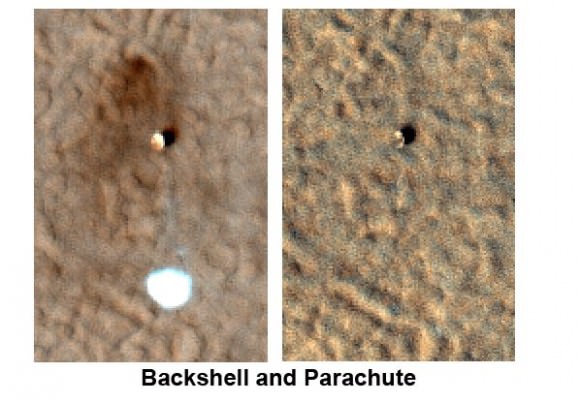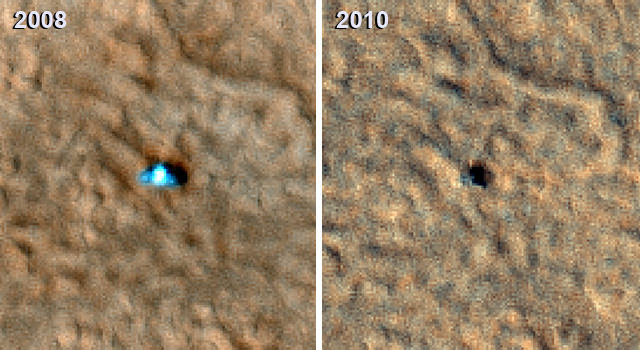[/caption]
The Phoenix lander will not be phoning home. A new image of Phoenix taken this month by the HiRISE camera (High Resolution Imaging Science Experiment) on board the Mars Reconnaissance Orbiter shows signs of severe ice damage to the lander’s solar panels, with one panel appearing to be completely gone. The Phoenix team says this is consistent with predictions of how Phoenix could be damaged by harsh winter conditions. It was anticipated that the weight of a carbon-dioxide ice buildup could bend or break the solar panels.
“Before and after images are dramatically different,” said Michael Mellon of the University of Colorado in Boulder, a science team member for both Phoenix and HiRISE. “The lander looks smaller, and only a portion of the difference can be explained by accumulation of dust on the lander, which makes its surfaces less distinguishable from surrounding ground.”
Mellon calculated hundreds of pounds of ice probably coated the lander in mid-winter. Several attempts to contact Phoenix during the past few months came up empty.

“We can see that the lander, heat shield, and backshell-plus-parachute are now covered by dust,” said Mellon and Alfred McEwen on the HiRISE website, “so they lack the distinctive colors of the hardware or the surfaces where the pre-landing dust was disturbed. But if the lander is structurally intact, it should cast the same shadows. While that is indeed the case for the shadow cast by the backshell (which came to rest on its side), that does not appear to be the case for the lander.”
See the larger image of all the various pieces of Phoenix on the HiRISE website.
So now, the Phoenix mission is officially over.
But during its mission on Mars, Phoenix confirmed and examined patches of the widespread deposits of underground water ice detected by Odyssey and identified a mineral called calcium carbonate that suggested occasional presence of thawed water. The lander also found soil chemistry with significant implications for life and observed falling snow. The mission’s biggest surprise was the discovery of perchlorate, an oxidizing chemical on Earth that is food for some microbes and potentially toxic for others.
“We found that the soil above the ice can act like a sponge, with perchlorate scavenging water from the atmosphere and holding on to it,” said Peter Smith, Phoenix principal investigator at the University of Arizona in Tucson. “You can have a thin film layer of water capable of being a habitable environment. A micro-world at the scale of grains of soil — that’s where the action is.”
The perchlorate results are shaping subsequent astrobiology research, as scientists investigate the implications of its antifreeze properties and potential use as an energy source by microbes. Discovery of the ice in the uppermost soil by Odyssey pointed the way for Phoenix. More recently, the Mars Reconnaissance Orbiter detected numerous ice deposits in middle latitudes at greater depth using radar and exposed on the surface by fresh impact craters.
“Ice-rich environments are an even bigger part of the planet than we thought,” Smith said. “Somewhere in that vast region there are going to be places that are more habitable than others.”
For more info and a look back at Phoenix, check out the Phoenix mission website.
Source: NASA


Dang… RIP Phoenix.
P.S. Who ate the parachute?
It was obviously the Martian subhumanoids that stole the panel…
… and the andtenna, and the arm, and radio …
The solar panel broke off, or got buried in the dust.
It’s good to have closure
Figures that ice, not heat, can do a Phoenix in. Rest in pieces, you earned it.
Who ate the parachute? Dust.
But if bacteria can brave oxygen surely they can handle a puny oxidizer like perchlorate.
I think people confused that toxicity with perchlorate high toxicity for animals with neural systems, evolved in environments with little perchlorate. Bacteria however is somewhat lacking in the neural area…
Phoenix is no more. This is about what I suspected would be its fate. I suppose after a few winters it will be reduced to pieces.
Perchlorates are toxic, and used in some rocket fuel oxidizers. It is nasty stuff. In fact martian soil is largely bad news for anything on Earth besides some chemical extremophyles. These discoveries have put further nails in the coffin for ideas of terriforming Mars or living there.
LC
@ LBC:
It is exactly that conflation of toxicities that I’m worried about.
Perchlorates aren’t specifically toxic for bacteria, and are used for food for others, see the article. The amount of perchlorates observed hasn’t been verified to be toxic for cells AFAIK. Specifically under Mars conditions where they remain stable, not rocket fuel conditions.
But we know that a much stronger and more toxic oxidizer, oxygen, is not a problem for bacteria (and other life) in concentrations and activities far beyond those seen on Mars. Would we then be concluding that this “is largely bad news for anything on Earth”? Yes, it was once, but remaining life adapted.
[Fun fact: Oxygen is highly toxic for, IIRC, the dark branch of photosynthesis because it evolved under reducing conditions, or at least non-oxygenic. Cyanobacteria can have up to 3 layers of bilayer cell membranes stacked around them in order to arrive at sufficient metabolic efficiency.]
As for the water activity of the soils, I once tried to compare with papers on comparable saline seas and soils here. Turned out that the upper range of Mars water activity is well in the comfort zone not only for extremophiles but for common enough mesophiles. The moderate pH (pH 7 – 8, IIRC) was certainly tolerable for most cells. Seems guppies and many plants prefer that range, in fact. So much for “bad news”.
Fact seems to be the possibility for life on Mars went up, not down, with the Phoenix finds of water, a decent water activity and a known metabolic energy source besides the known carbon dioxide food source. Other predictions seems to have failed current available tests.
Assuming the local found perchlorates are planet wide distributed, yes.
But we don’t know that. In fact, there is work ongoing to see if “in the context of these Phoenix discoveries to establish whether the Viking data sets are consistent with the presence of perchlorate (and related compounds) and carbonates at those two landing sites.”
And perchlorates/water activity would not be a hinder to terraforming anyway as seen from the above, just for immediate living.
She was always going to be dead. The damn MERs have just got us so used to a constant stream of miracles from the red planet that we have almost come to expect them these days!
Would have been interesting to see the exact moment that it all went pear shaped for it. Man I wish there was someway of having a little camera on there that could endure into winter to have seen the build-up of ice and whatnot, and send it’s faint signal out to be picked up and relayed by MRO or something.
The missing parachute is most interesting.
Was it buried in the dust?
I’m also curious about the (its not ice!)ice pack this thing was buried under. Must have been thick enough to snap the panels but still leave the lander.
Seeing that we aren’t seeing the missing panel either, likely yes, wouldn’t you say?
There is bacteria in our own oceans which thrive in areas once considered too toxic for life. There is all sorts of toxic crap being thrust up from the Earth yet life thrives in it.
TL brings up a good point… if the toxin would tend to work on a nervous system, if there isn’t a nervous system to work on… there isn’t going to be a problem.
It’s also amazing what life can adapt to on its own.
Am curious about what the parachute was made from?
Nylon or Dacron is typically used these days…
It seems reasonable to assume that the nylon or dacron that was used to make the parachute melted away in contact with perchlorate?
TL, a pile of dust blown to one side of the lander can also hide the shadow since the pile has the same colour of the background.
Maybe in the future we will know. what really happened
Perchlorates are a source for some bacteria on Earth, and clearly if there exist martian bacteria they have evolved in this region for perchlorates. However, these are very specialized micro-organisms and evolved for these chemical conditions. Most complex Earth life would not survive. The idea of throwing up an air pressure domes and growing food is unlikely. Other regions of Mars appear to be extremely alkaline and toxic for most Earth life as well.
LC